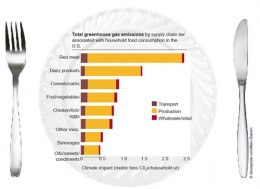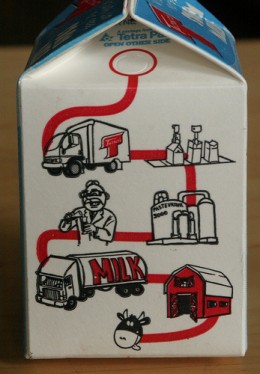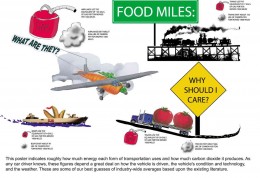By Danielle Kennedy
This is the first of a two-part article. Click the link to read Part 2 on fair trade.
With all of you as our awesome supporters, it’s easy to forget sometimes that not everyone is on board with the local movement. In any movement, it is vital to address both sides of an issue, and with Wal-Mart’s upcoming potential foray into Somerville territory and the community dialogue that has already ensued, I think now is a more important time than ever to address our opposition and consider their points.
Although there are a few different arguments the opposition uses, I’ll start with an environmental focus. This argument mostly focuses around local food systems, and detractors often claim that buying local actually does not cause a significant reduction of our carbon footprint. The idea is that, in terms of transportation, mass production can be efficient because it is easier to transport many products in bulk over a long distance than transporting it with several small trucks over very short distances as is often the case with farmer’s markets, where many small local farmers are individually transporting their goods.
While the statistic they often point to, that “it uses the same amount of fuel to transport 200 dozen eggs 200 miles as it does 20 dozen eggs 20 miles,” may be true, I feel that this write-off of the environmental impact is pretty simplistic.Aside from undergoing this single, long-distance shipment, commercially-produced foods usually go through several smaller trips, travelling through processing and packaging plants before perhaps residing at a distribution center, from which products are carted off to various supermarkets in smaller quantities as needed. Local food sourcers usually only take one trip, from farm to market.
In fact, the entire practice of producing food to prepare for the long journey it must undergo can be said to be the true carbon culprit. In a 2008 article for Conservation Magazine, Natasha Loder suggests that shipping does not account for a significant percentage of carbon emissions involved in food consumption (“83 percent of the average U.S. household’s carbon footprint for food consumption comes from production”), and therefore, buying local for this particular reason is not worth it. However, she fails to see that the entire food production process depends on what type of farm is producing the food. Local farmers do not need to prepare their goods to be shipped long distances and last several days before reaching your kitchen. Without the need for lots of packaging and preserving, the environmental impact is lessened. Small local farms also are more likely to use green organic growing methods because it is more feasible, which means less greenhouse gas-producing fertilizers and devastating monocultures.

Source: Weber, C.L. and Matthews, H.S. 2008. Food-miles and the relative climate impacts of food choices in the United States. Environmental Science & Technology 42(10):3508–3513.
The opposition’s logic also ignores the most important people in any economy – consumers – who are not making their purchases in bulk and may even run up to the store for a single product that they need at a time. Most non-local groceries end up in supermarkets and big box stores, which, because of the amount of space they require, tend to be built far away from where people live. Consumers are more likely to drive to such locations, as they are more difficult to get to by public transportation and compel people to buy more at once (more than they can carry by foot or cart) because of the distance. When food or other products are made available locally, people are more likely and able to use alternative forms of transportation to get to those stores, equaling less individual carbon-producing car trips.
Many people against buying local also argue that the effort it takes to grow certain foods in local locations outweighs any benefit that the decreased food miles might have. In a June op-ed article written for the Globe, author Ed Glaeser cites a recent UK report that found the process involved in producing local tomatoes in England emitted about three times as many greenhouse gases as importing Spanish tomatoes.
This may seem like a sound argument at first, but one must realize that a key part of authentically eating locally means eating seasonally. If you live in Massachusetts and buy tomatoes in May or June before the peak of the season in July, you must do so with the knowledge that they were either grown in an energy-expensive greenhouse or aren’t from Massachusetts.
Now, I may have just spent the last several hundred words arguing against the opposition, but every argument has its reason. So when they use the, “it uses the same amount of fuel…” line, the most powerful argument you can make is to actually DO something about it – that’s what movements are for, anyway. Vanessa Rule of Somerville Climate Action and New England Climate Summer says, “Buying local, in keeping dollars in the local economy, allows local producers to develop business relationships with each other, which also decreases miles of product travel. One business’s waste can become another’s resource.” Take a hint from Vanessa - organize your local farms into a produce “carpool” program, because while driving 20 dozen eggs 20 miles might not be ideal, it’s certainly more efficient to transport 200 dozen eggs the same distance. Encourage local businesses to use greener transportation methods, and don’t give the opposition anything to argue about.
Unfortunately, sustainability is not the only issue we must defend here…keep an eye out for Part 2 of this article, and in the meantime, comment below – do you agree or disagree?



